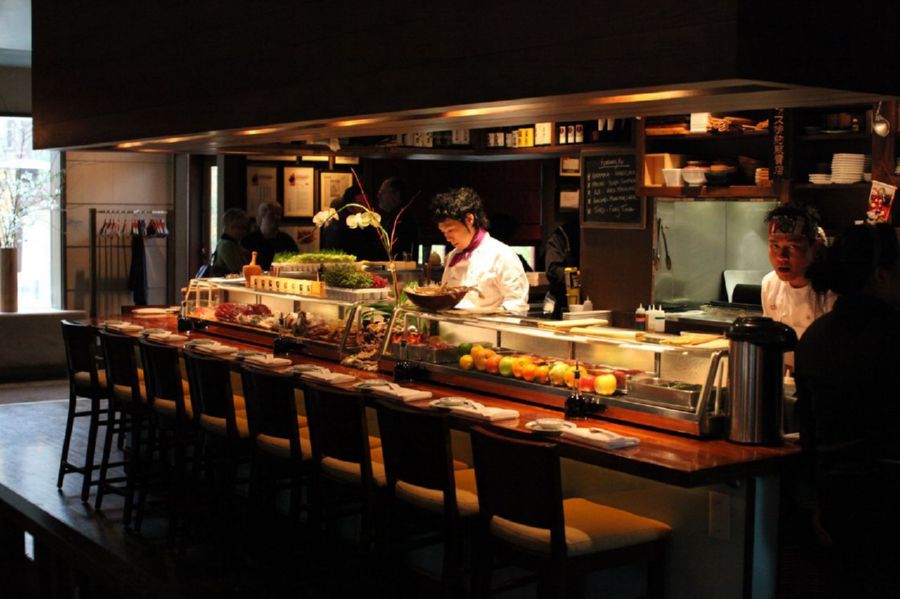Did you know there are an estimated 25,300 Japanese restaurants operating in the United States alone? According to this report there are over 100,000 Japanese themed restaurants operating outside of Japan. It’s safe to say Japanese food is now enjoyed globally.
With sushi bars being one of the most popular types of Japanese restaurant in the United States, many owned by Chinese immigrants to the country, it shouldn’t come as much of a surprise that the sushi restaurant industry is currently worth more than $20 billion dollars a year.
Based on consumer demand there’s never been a better time to open a Japanese restaurant in America. In today’s post, we share some of our expert’s best options for choosing a new brand names in this segment of the restaurant industry.
Japanese Restaurant Name Ideas

Inside a typical Japanese restaurant in the United States.
Japanese restaurants typically offer all of the westernized Japanese cuisine for customers, which gives you broad range of dishes. And there are even more options available when it comes to choosing your restaurant’s name with options in Japanese kanji in addition to English.
Related Reading: Cooking is My Passion. Should I Start a Restaurant?
- Anago
- Casual Kaiseki
- Chanoyu
- Domo Furai
- Dragon and Eel
- Dragon Kin
- Edamame
- Ember Days
- Enni’s Myth
- Futamono
- Heian-kyo
- House of Bamboo
- Ikura
- Kamaboko
- Kamakura
- Kappa Maki
- Korokke Hai
- Kukai’s Offering
- Midnight Noodle
- Muromachiy
- Nigiri House
- Oshiki
- San San Kudo
- Sen no Rikyu
- Shichigosan
- Shiki-Sankon
- Shogun
- Stix
- The Battered Yam
- The Crispy prawn
- The Fourth Tradition
- The Noodle Exchange
- The Passions of Rice
- The Warrior’s Table
- Tonkatsu Domo
- Trip to Japan
- Gourmet Japanese
- Travel East
Sushi Restaurant Name Ideas

Sushi is the most recognized Japanese cuisine in the United States.
Sushi is the most popular type of Japanese food and is actually more popular in the United States than it is in Japan now if you can believe that. Finding a descriptive name for your restaurant really can be as easy as adding the word “sushi” to the end of your Japanese name. Here are some examples below.
- 寿司(Sushi in Kanji Nihongo)
- Arashi Sushi
- Asahi Sushi
- Dojo Sushi
- Ebisu Sushi
- Hama Sushi
- Hikari Sushi
- Kantaro Sushi
- Kaya Sushi
- Kazoku Sushi
- Limin’ Sushi
- Love Sushi
- Maho sushi
- Mako Sushi
- Makoto Sushi
- Mamasushi
- Samurai Sushi
- Skizuke
- Sumo Sushi
- Sushi & Saki
- Sushi Eyaki
- Sushi Fumi
- Sushi Gen
- Sushi Ginza Onodera
- Sushi John’s
- Sushi Katsuei
- Sushi of the Sea
- Sushi Sen-Nin
- Sushi Tsujita
- Sushi Yasaka
- Sushiio
- Sushiverse
- Tanto
- Tosai Sushi
- Toshi Sushi
- So Much Sushi
- Sally Makes Sushi
- Sir Sushi
- Octopus Sushi Co.
- 21st Century Sushi
- Sister’s Sushi House
Funny Sushi Restaurant Names

Try giving your sushi restaurant a laugh out loud name!
Believe it or not, naming a sushi restaurant can actually be fun! There are plenty of puns that can be incorporated into the brand name. You can make the process as playful as you like to bring out the less demure side of this cuisine.
- Asukama Sushi Poke
- Atomic Sushi
- Bento Sushi
- Emperor’s Sushi
- For Pete’s Sake
- Gaijin Sushi
- Gatten Sushi
- Harakiri Sushi
- Hirohito’s Sushi Shop
- Honshu Sushi
- Itacho Sushi Restaurant
- Kaiju Sushi
- Katana Sushi
- KazuNori
- Kinza Sushi
- Kodama Sushi
- Maki Taki
- Matsumoto’s
- Miso Hungry
- Mission Sushi
- Momo Sushi
- Nippon Sushi
- Nori Wraps
- Raw Delights
- Raw Fish in Seaweed
- Rice Rolls
- Rising Sun Sushi
- Rolls of Fish
- Rolls Royce Sushi
- Sticky Rice
- Sushi Al Dente
- Sushi Dojo
- Sushi Hai
- Sushi Junkies
- Suzie Sushi
- Slasher Sushi
- Sickie Sushi
Ramen Restaurant Name Ideas

Examples of ramen dishes.
Ramen, the delicious soup from the Land of the Rising Sun is another popular theme for restaurants in the United States. Many ramen establishments include the phrase “ramen house” in the name anyway to distinguish from other types of Japanese food. You can also use the best and most unusual Nihongo words in your brand name with a ramen restaurant. Here are some of the best suggestions.
- ラーメン (Ramen in Katakana Nihongo)
- Ajisai Ramen House
- Amaebi Ramen
- Cherin Ramen
- Hai Ramen
- Kahuna Tiki Ramen House
- Kakata Tonton Domo Ramen
- Katsuya Live Domo Ramen
- Kiriko Ramen House
- Kurumazushi
- Matshuhisa Ramen House
- Menkui-Tei Ramen House
- Mikado Ramen House
- Momoya House of Ramen
- Muraya House of Ramen
- Nagomi House of Ramen
- Nozomi Domo Ramen
- Onkei Ramen
- Osen Izakaya Domo Ramen
- Otomisan Domo Ramen
- Pazzaz Sushi House of Ramen
- Ramen Domo
- Ramen Le
- Ramen Maruya
- Riki
- Robata Jinya House of Ramen
- Roku Sunset
- Sakagura Ramen House
- Sake House Miro Ramen
- Shinbashi House of Ramen
- Shojin House of Ramen
- Sora Domo Ramen
- Sumo Sushi Domo Ramen
- Takao Domo Ramen
- Umami Noodle and Ramen Bar
- Rock and Roll Ramen
- Rolling Ramen
- Randy Make Ramen
- Not Your College Ramen
Cute Japanese Cafe Name Ideas

Cafés or kissaten are a major part of Japanese dining culture.
Japanese cafés are often themed places. For example in Japan you can find a pokemon café, robot café, maid café, and many more. Known in Japan as “kissaten” or a tea-drinking shop, American versions are more like coffee shops with a Japanese twist. Your café can be given a variety of names and does not need to include “café” since most offer Japanese food as well.
- Ariyoshi Café
- Asanebo
- Asuka
- A-Won Café
- Banzai
- Bar Hayama
- Bento Ya
- Boongho
- Cagen
- Chaya
- Chiba
- Cho Cho San
- Cho-Oishi
- Donguri
- Echigo
- Fuji Dojo
- Fukurou
- Hamasaku
- Hanabi
- Inshoku-ten
- Kanoyama
- Kifune
- Manayoki
- Miyako Express
- Shibucho
- Shibumi
- Shikuba
- Shima
- Shimizu
- Shinbashi
- Soregashi
- Tataki
- Teisui
- Totoraku
- Yama
How To Name a Japanese Restaurant

Choose your Japanese restaurant name carefully.
Obviously, most Japanese restaurant names has some connection to the country of Japan. Or they at least have some Japanese words or writing in the title. But you still need to make sure the name rings true to your brand idea and the theme. The name must make sense and logically describe you menu to avoid confusion.
Names for Japanese restaurants are divided into two main groups: those that include Japanese words of kanji in the name and those that have names that are only English words. Which you chose is entirely up to you, but you should relate the brand to the style of restaurant you are opening and cuisine you serve.
Related Reading: How I Opened a Restaurant with No Money and 540 Credit Score
Using English words only is a great way of showing the brand name in a way that will be more easily interpreted by your clientele in the United States. Including Japanese words will be over the head of the average diner. Complex names can be detrimental to business.
These English-named restaurants can be associated with the type of Japanese food, such as sushi restaurants, where you can incorporate the word “sushi” into the name, such as Sea Breeze Sushi. Or you can adopt a more broad Japanese style of naming like the Rising Sun Restaurant or Fuji Sushi Bar as examples. These catchy titles can help your restaurant be more memorable and easy to tell others about.
Another option for naming a Japanese restaurant is to use more Japanese themes and words in the name itself. This way, your inclusion of Japanese or Nihongo can help to make your restaurant more easily recognizable as Japanese. If you plan to open in an area with a significant Japanese population this is a fantastic approach.
You can combine the Japanese names with typical keywords, such as restaurant, teriyaki, sushi, maki, or just use the Japanese or Nihongo word on its own, such as Shojjin, Kifune, Soregashi, etc. You can even use the traditional Japanese script (ラーメン – Ramen in Katakana Nihongo), which denotes the restaurant automatically as Japanese. You may need to place the English translation under your sign though or just use the term “Japanese Restaurant” along with it to make your specialty clear.
A third typical way to name your Japanese restaurant is to give it a name of something so typically Japanese that it could be easily recognized by anyone from anywhere in the world. Examples of this would be names like The Banzai Café, Mount Fuji, or Samurai Sashimi, which articulate the Japanese element.
If you’re planning to open a restaurant, don’t forget to download our free menu cost calculator tool. This tool will help you understand the cost and profitability of each item on your menu.




